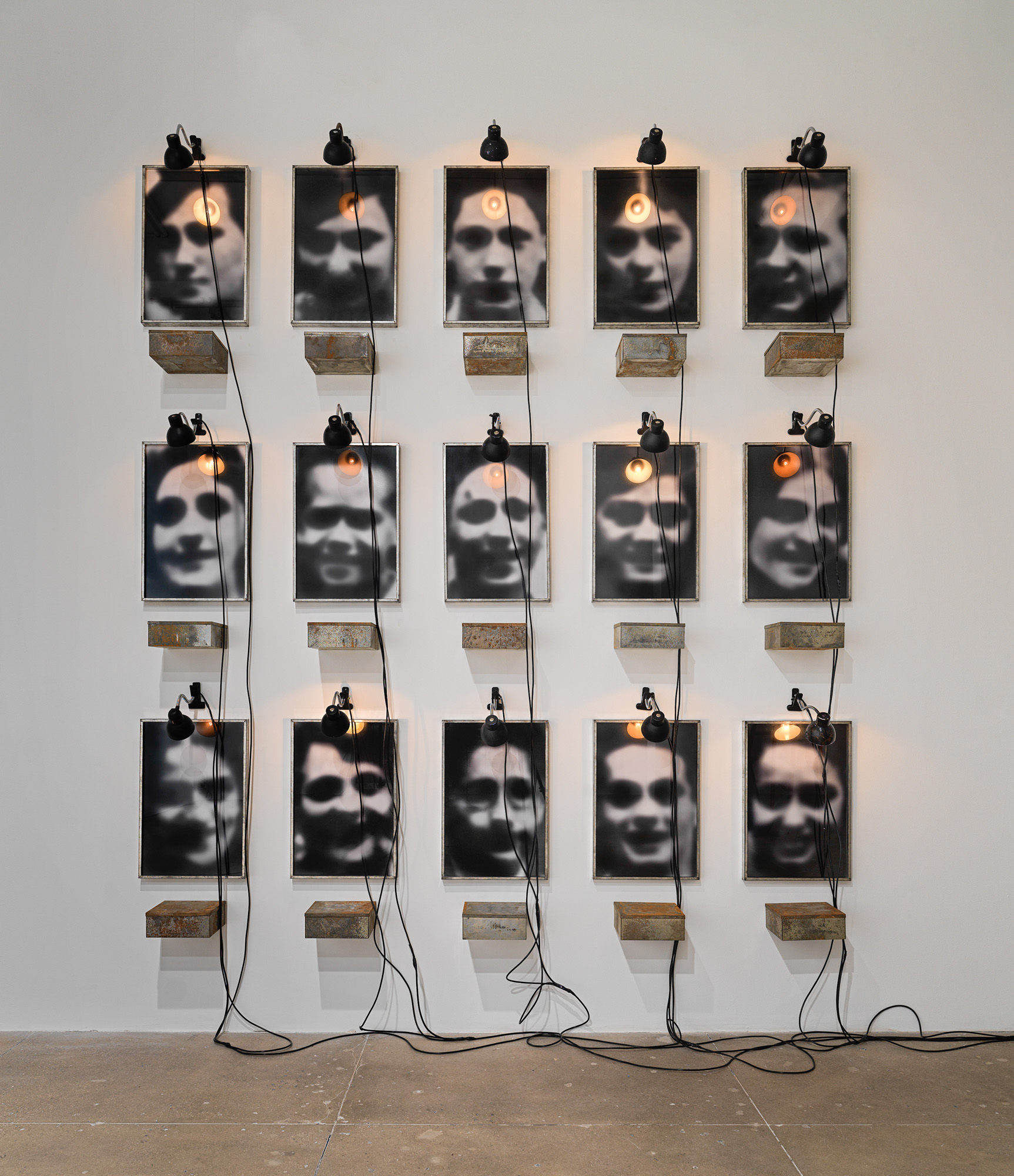One On One: Leung Chi Wo on Christian Boltanski
By Leung Chi Wo
Full text also available in Chinese.

CHRISTIAN BOLTANSKI, Lycee Chases, 1987, five tin boxes, 15 photographs, 15 black lamps, electric wire, 297.2 × 266.7 × 30.5 cm. Photo by Alex Yudzon. Courtesy the Christian Boltanski Studio and Marian Goodman Gallery, New York/Paris.
I went to art school in Hong Kong in the late 1980s when the future of this former colony was settled with a date that was somehow remote for me—ten years is long for a teenager. I was naive; art, society, identity, and sovereignty were not necessarily on my mind.
One of my teachers once said the art trends in Hong Kong back then were somehow ten years behind the mainstream in the West. Many active artists were doing neo-expressionist paintings, which most of my classmates at the Chinese University of Hong Kong also focused on. I had no idea what I could do—but for sure, I didn’t paint well. I picked up photography, something not taught in our school. I could only say I was a bit self-centered and tended to be retrospective, perhaps even nostalgic for the simple days one has as a young kid. In my second year of study, I got a summer job in the United States and planned for a backpacking journey afterwards for two months. It was 1988 and my last stop was in Los Angeles. In what was then called MOCA’s Temporary Contemporary, I saw a beautiful exhibition of many small, framed and dimly illuminated black-and-white portraits of children, vintage clothes, and stacks of metal boxes. There was also a spectacular but detailed shadow-play installation. There was not much about it that I understood, except there was a sort of tension when I walked close to the work. The experience of being in front of the installations was complex, which I found difficult to describe. I was simply moved. The children depicted in the photographs and the clothes in the frames seemed to be indicative, referring to culturally specific matters on the one hand but also something universal.
I was very impressed and took many photos. I didn’t know the artist and couldn’t pronounce his last name. Upon returning to Hong Kong, I could only remember his first name was Christian. It was a time without the internet. I couldn’t find any books about this artist. Some months later I came across a feature about the exhibition in Art in America. Yes, it was Boltanski, the artist who lamented his and others’ stolen childhoods. As a 20-year-old art student, I learned about death for the first time, not as the end of an individual’s life but as the termination of history, as it could be fabricated, the way Boltanski did in his memorial-like sculptures. There, individual memory thrived, encouraging us to tame or contemplate the intractable past.
After my graduation, I was not sure about pursuing art but struggled to defer any conclusion; I had more journeys ahead to travel and to study. I went on a camping trip in Italy with my partner, and we spent our first night right next to a small cemetery on Isola Maggiore in a lake in Umbria. It was illegal to camp out there, but there was nobody around. We only put up our tent when the sun went down to avoid attention. That evening I walked past the gate of the columbarium to reach the freshwater tap. I saw a wall of niches with miniature portraits and candle votives. I couldn’t help recalling Boltanski’s installations of small lamps shining on anonymous portraits. I was unsure if that’s what he referred to. I sensed no fear or sadness but only calm and peace there. For the first time in my life, I reckoned death could be reduced to purity. I was not religious at all but left in a deep state, like sitting before the silence of a Noh theater performance.
In the early 1990s, Boltanski was everywhere in the art media. His artistic language was accessible. Quickly you even found your friends in Hong Kong were his fans. His popularity also rose with widespread study of semiotics in art institutions. The first Para Site exhibition, “Relic/Image” in 1996, indeed reflected this trend, with reference to the idea in David Clarke’s essay “The Icon and the Index: Modes of Invoking the Body’s Presence” (1992) that the mediums of photography and vintage objects function beyond grand narratives. While I realized we had our own agendas and memories, Boltanski’s notion of relics—artworks as remains of the artist within the museum as the cemetery—was still relevant across cultures and times.
Over the years, his presence has gradually receded, long before the end of his life in 2021. I never had the opportunity to meet him in person, but once in a while when I saw his work in exhibitions, I would recall my first Boltanski experience. It allowed contradictions: both a celebration and mourning of memory and the past, of someone and everyone. Though I have never visited his installation of heartbeats of people from around the world, Les Archives du Coeur (2010), on Teshima Island in Japan, I feel I already experienced it on Isola Maggiore.
.jpg)






